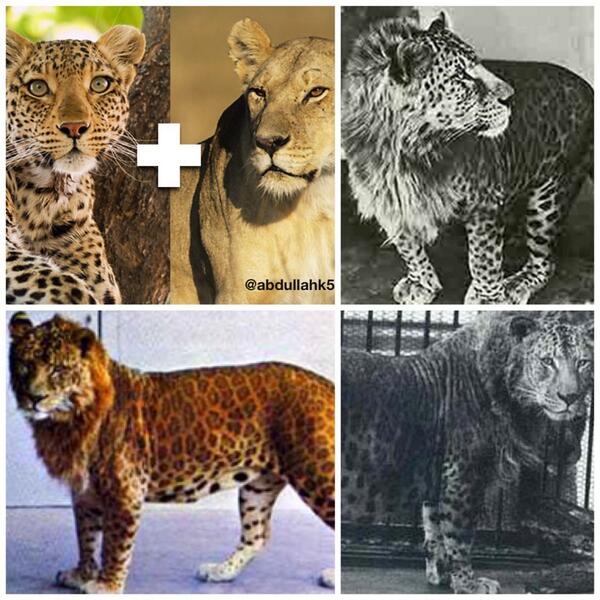<Some of these animals might be on our site and some may not.>
1. Liger
The Liger is a hybrid cross between a male lion and a female tiger, thus both its parents are from the Panthera genus, but from different species. Ligers are the biggest of all the big cats, growing to almost the lion and tigers combined size. They carry characteristics from both parents, for instance their love of swimming from tigers and their highly social behavior from lions.
2. Coywolf

The Coywolf is essentially a Coyote and a wolf hybrid, that regularly occurs in nature. So regular, in fact, that all known red wolves have been found to have coyote genes in their lineage. It is not clear whether this inbreeding has occurred as a result of Human development limiting their natural habitat, or if the Red wolf has just always been a hybrid. This animal has caused a lot of problems in the Canid taxonomy, as hybrids are not usually referred to as a different species, though convention would call the red wolf a sub species of the wolf, leaving its Latin name without a mention of its coyote genes.
3. Wolf Dog

Wolf dogs can better be described as companions than pets. They are smarter than most "domestic" breeds of dogs, are self aware, aware of their surroundings, will challenge even the most experienced caretakers with their stubbornness and "what's in it for me" attitude, and in general are the most predictable canine as wolves are the model for canine behavior and wolfdogs tend to display emotions very well.
4. Savannah Cat

The Savannah is a fairly modern domestic cat creation that was accepted as a new breed in 2001, by the International Cat Association. This cat is a hybrid of the domestic cat and the wild African Serval. Savannah’s are a lot more social than most domestic cat breeds, and have often been compared to dogs because of their extreme loyalty. The Savannah is a large cat with a very slim body. They are the highest jumpers, and the tallest cats in the cat world. Savannah’s can come in almost all colors, depending on what domestic cat was bred with the serval, they will always, however, have that spotted or marbled appearance. Depending on what generation hybrid the savannah is, will determine how wild and large the cat appears, and they often look very similar to a miniature version of a cheetah.
5. Zorse

A zorse is a "zebroid"—the generic name for all zebra hybrids. Types of zebroids include the zony, which is a cross between a zebra stallion and pony mare, as well as the zedonk (a.k.a. zonkey or zebronkey), a cross between a Zebra stallion and donkey jenny. Zebroids can be pretty feisty and are said to be much more temperamental and difficult to handle than purebred horses
6. Grolar Bear

Because polar bears and grizzlies both live by themselves in large open habitats, the probability of these two coming together as star-crossed lovers is slim. Althoughgrolar bear sightings have been reported in the past, neither species can survive long in the other’s ecological niche; plus, they have very different social and feeding behaviours. In 2006, near Sachs Harbour in the Northwest Territories, a hunter from Idaho named Jim Martell found and shot a grizzly–polar bear hybrid, believing it was a normal polar bear. Had the bear been deemed a grizzly, he would have faced a possible $1,000 fine and up to a year in jail.
7. Wholpins

This is a very rare hybrid, between a false killer whale and a bottlenose dolphin. Wolphins are a perfect example of a cross-breed, as their shape, color and size are very much intermediate between dolphins and whales. As of today, only two such wolphins exist, which can be seen at Sea Life Park, Hawaii.
8. Blood Parrot Cichild

An unusual, bright orange colored fish, that has a red body and deformed swim bladders, is the blood parrot. The fish is thought to have been bred from a severum and red devil cichlid or possibly from a midas cichlid and a redhead cichlid. Another deformity is its beak-like mouth, due to which feeding this fish becomes a hard task for the owner. Many are against such unusual hybrids and there have been moves to remove from the market and from other pet stores.
9. Leopon

The cross between a lioness and lepoard which is really rare as usually the lioness is much larger than a leopard and this mating in the wild would usually result in the death of the leopard.
10. Sheep Pig

This is a sheep-pig. Unfortunately, they're not actually part-sheep. They are, however, a cross between a pig and a super-duper rare pig called a Lincolnshire curly coat.
What do you think of our list?
Leave your comments below.
Info Taken from http://scribol.com/environment/10-incredible-animal-hybrids/10
http://www.viralnova.com/real-animal-hybrids/
http://www.readersdigest.ca/pets/breeds/8-strange-animal-hybrids
http://www.weirdworm.com/7-coolest-animal-cross-breeds/2/
http://www.mnn.com/earth-matters/animals/photos/11-amazing-hybrid-animals/mixing-things-up
http://www.dogbreedinfo.com/w/wolfdog.htm




-white-background.jpg)